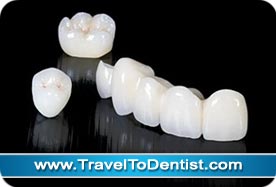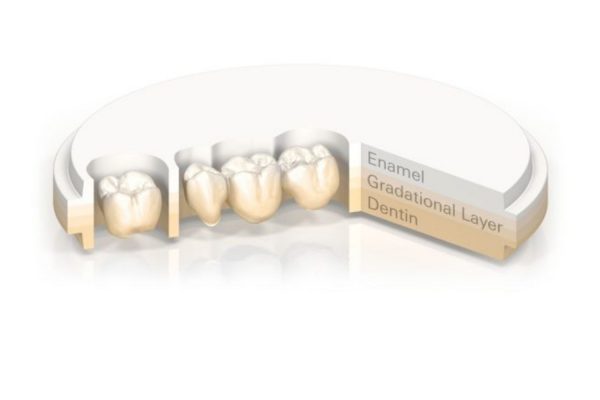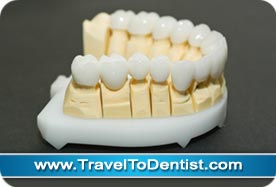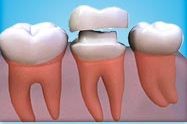
What is the zirconium crown?
Zirconium Crown is a type of dental crown which has zirconium as a raw material in its manufacture. It can be used both for veneering natural teeth and for dental implants. Moreover, thanks to its resistance, dental bridges of various sizes can also be made.
Zirconium crown is also called zirconium crown, zirconium oxide crown, zirconium capsule, ceramic zirconium crown, zirconium teeth.
Today, the requests from patients for this type of dental crown have increased significantly as it is able to meet almost all patient needs, for example:
- is white and aesthetic,
- it is prepared quickly,
- lasts a long time.
Brief history: the evolution of zirconium
Today, zirconium is constantly evolving, because it perfectly replaces metal in the preparation of dental crowns and bridges (chromium, cobalt, nickel, vanadium, strontium), and this makes us think that we are switching to metal-free dental solutions (zirconium, ceramic).
What types of zirconium crowns are there?
- layered zirconium (zirconium base and ceramic coating),
- monolithic zirconium (full contour, anatomical),

In this image we see a zirconium disc. We notice a gradual chromatic scale. At the base of the tooth the color is darker and the edge lighter. This type of zirconium is used to make integral zirconia crowns (monolithic, fully anatomical) that perfectly mimic the natural tooth. We also note the high transparency of the crowns, even if no ceramic was used.
Layered zirconium, as mentioned above, has been introduced as a metal substitute in the manufacture of dental crowns. Therefore, the greatest benefit obtained from this typology is the high aesthetics, but it has also been noted that the ceramic often chipped, especially in total mouth rehabilitations.
Monolithic zirconium comes in different shapes and structures, each of which is indicated for a specific problem to be solved, such as:
- for dental bridges (longer life and less transparency);
- for posterior / lateral teeth (molars) with a correct balance between transparency and durability;
- for front teeth (minimal layering, only on the outer part of the crown – the visible part);
- for anterior and posterior teeth (ceramic-free thanks to the multi-layer structure) See the picture above!
- for bruxism (with a higher durability along the entire crown: both the neck part and the incisal margin).
Which one to choose? Comparison between layered and fully anatomical work
In the table below, we want to present the differences between layered and full anatomical crowns (version we want to move to in the next few times). We want to clarify that the metal-ceramic crowns are part of the group of layered works(layers of ceramic are added on a zirconium or metal support).
Therefore, the information in this table refers to the difference between DEFINITIVE works: layered (zirconium ceramic or metal-ceramic) and fully anatomical ones made only of zirconium.
| Layered dental crowns | object of comparison | Full anatomic dental crowns (monolithic zirconium) |
| The ceramic is manually layered on the zirconia or metal frame, leaving a margin for error (the human factor). | precision | The monolithic zirconia crown is modeled and milled entirely using CAD CAM technology – then all controlled or with computer help (CAD = Computer Aided Design – translated from English would be Computer Aided Design. CAM = Computer Aided Manufacturing = Manufacturing aided by computer). So monolithic zirconium is more precise than layered zirconium. |
| The entire process of making the layered dental crown is longer, because it is performed manually and from 3 to 6 ceramic layers are added which in turn require more time due to the steps performed by hand, firing each ceramic layer, cooling etc. | time | By making a monolithic zirconium crown, you save a lot of time, compared to the layered one. In a few hours, the dental crown will be modeled in EXOCAD, 3Shape or inLab software, and the CAD CAM milling machine only needs 1-6 hours to mill the entire job. |
| The layered dental crowns are more aesthetic because the ceramic can be modeled by hand, in a more artistic way, different natural effects such as stains, small cracks or structural irregularities specific to the natural tooth can be used. | aesthetic | Monolithic zirconium crowns are considered less aesthetic than layered zirconium, but here the patient can actively participate in the fabrication of their teeth. Alongside the dental technician, he can be involved by suggesting the shape he prefers. Thanks to the facial scanner, the patient can pre-preview the modeled result in their mouth on the computer (virtually) and can decide whether certain tooth shapes are more suitable for them. |
| When working manually on layered dental crowns, the dental technician has to make several tests in the patient’s mouth to check the occlusion and contacts. Any functional or even aesthetic problem will lead to subsequent changes that can weaken the prosthetic work (for each firing in the kiln, the ceramic becomes more fragile). | quality check | Modeling the dental crowns in the software, you can see the errors immediately and you can make the changes on the spot. By scanning the patient’s face with the facial scanner, the correct length and width of the teeth, occlusion and contacts can be better known. In case something is passed, the software has the function of warning about this problem. |
| The greatest risk of veneered zirconium or even metal crowns is that of chipping of the ceramic. In some cases, this problem can be caused by patient neglect or bruxism which is not always covered by the warranty, and therefore involves some expense in correcting the defects created. | possible risks and money savings | The risk of chipping no longer exists because we do not have ceramic, but only teeth completely in zirconium (full anatomic). For this reason, the risks and financial losses associated with them are minimized. |
Reflections on the comparison table
What made zirconium so popular was first of all – yes: the lack of metal, but one of the strongest and most important points is the technique and the way it is made, through the CAD CAM milling machine.
Monolithic zirconium is made entirely in CAD CAM. Our opinion is that we must always keep abreast of evolution, modernization and we must conquer technology. In fact, nowadays everything goes digital, to intelligent robots and software that do the job faster, qualitatively and more precisely.
However, there are cases where the hand of the man / dental technician (layered work) can prevail. For example, when we have a unitary work (one tooth) or when we have to replace only a few teeth, then only the dental technician can best adapt the dental crown in the mouth. The artist’s hand will be able to best reproduce particular details of the new dental crown in order to get closer to the adjacent natural tooth.
If, however, you want an answer to the question in the paragraph title: Which to choose? So, our answer is that you have to choose a trusted doctor and clinic.
La scelta del paziente deve essere lo zirconio come materiale in sé (vedi più sotto il perché), ulteriormente il medico lo guiderà correttamente nella scelta del tipo di zirconio, a secondo delle preferenze, del caso clinico e la sua complessità.
Why should i choose zirconium itself? Which are its advantages?

- Crowns in zirconium are lighterthan those in metal-ceramic but up to 50% more resistant;
- Zirconium is absolutely compatible with the human body. This is not a metal and does not cause any type of allergy;
- Being completely white, with gingival shrinkage or chipping, you will not notice black borders as happened with metal ceramic crowns, so they keep their beautiful appearance longer;
- The zirconium crowns limit the adhesion of bacterial plaque;
- Zirconium oxide is not transparent to light unlike pure ceramic, therefore even gray teeth, being covered, can become very aesthetic;
- The zirconium crown has a low thermal conductivity (because it has no metal parts) which allows you to eat hot and cold food without experiencing unpleasant sensations caused by temperature.
The use of zirconium represents an important phase for the future of aesthetic dentistry. This material accepted by every organism, perfectly integrated into the smile of patients, has already been used successfully in many modern dental clinics to produce zirconium dental crowns of unsurpassed aesthetics. This technique is becoming more and more popular on a large scale in the field of cosmetic dentistry and its popularity will increase significantly.
















Spelling error report
The following text will be sent to our editors: